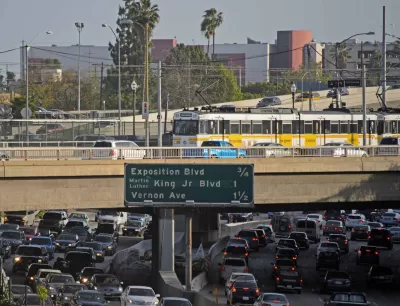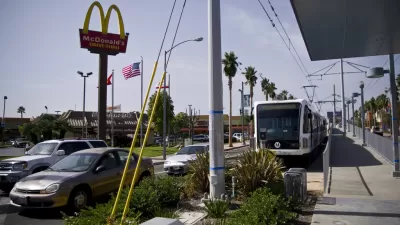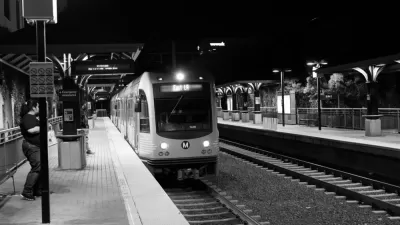Bus riders, comprising about three-quarters of Los Angeles Metro ridership, declined 21 percent since 2013, But it wasn't just bus routes—two light rail lines also lost riders.

"Despite a growing population and an improving economy, the number of trips taken on Los Angeles County's bus and rail network last year fell to the lowest level in more than a decade," reports Laura J. Nelson, who covers transportation and mobility issues across Southern California for the Los Angeles Times, on Jan. 25.
The Los Angeles County Metropolitan Transportation Authority, or Metro, is the third largest public transit agency in the U.S. ranked by ridership, according to APTA [pdf].
Rail ridership increased 3.6 percent over five years, bolstered by significant ridership gains on the Expo Line on the new extension to Santa Monica and Gold Line extension to Azusa, adds Nelson, but the Blue and Green light rail lines saw ridership drop 21 percent and 26 percent, respectively.
So, why the drop, though It should be noted that bus ridership is falling nationwide, with Seattle a major exception.
Experts and officials have no firm answers, but have attributed the decline to a combination of factors, including changes to immigration policy, competition from Uber and Lyft and more people buying cars — as well as perceived problems with existing transit service and security. [Note the anecdote by Councilwoman Nury Martinez in the article.]
Nearly two-thirds of former Metro riders told the agency in a 2016 survey that they stopped riding because transit service was inefficient, inconvenient or difficult to reach. An additional 29% said they stopped riding because they felt unsafe or uncomfortable on buses and trains. The vast majority of those people now drive alone.
One study prepared by UCLA for the Southern California Assn. of Governments suggests that the region simply has more cars available per resident than in the past, making driving easier and making traffic worse.
The change in immigration policy refers to a 2015 state law that allows undocumented immigrants to apply for driver's licenses.
Nelson delves into many strategies, such as bus-only lanes and all-door boarding that would increase bus efficiency, but she also notes their challenges.
It will be interesting to see if the $120 billion expected investment over the next 40 years from Measure M, passed by county voters in 2016, can reverse the trend. That Metro is already using the new sales tax dollars to invest in local bus service, particularly in non-Metro local lines, is a good sign.
"It wouldn't be difficult to turn these [ridership] figures around, as Metro's history shows: The transportation authority should stop focusing primarily on building new rail and use a fair share of its voter-supplied wealth to lower fares and improve the bus system," opined James E. Moore Il and Thomas A. Rubin in an op-ed for the Los Angeles Times on Nov. 10, 2017.
For an alternative look at Metro ridership, particularly rail ridership, see Ethan Elkind's blog, "L.A. Times Misleads On Metro Rail Ridership History," dated January 27, 2016.
Hat tip to Julie Bloom via New York Times - California Today.
FULL STORY: Ridership on Metro fell to the lowest level in more than a decade last year

Planetizen Federal Action Tracker
A weekly monitor of how Trump’s orders and actions are impacting planners and planning in America.

Map: Where Senate Republicans Want to Sell Your Public Lands
For public land advocates, the Senate Republicans’ proposal to sell millions of acres of public land in the West is “the biggest fight of their careers.”

Restaurant Patios Were a Pandemic Win — Why Were They so Hard to Keep?
Social distancing requirements and changes in travel patterns prompted cities to pilot new uses for street and sidewalk space. Then it got complicated.

Platform Pilsner: Vancouver Transit Agency Releases... a Beer?
TransLink will receive a portion of every sale of the four-pack.

Toronto Weighs Cheaper Transit, Parking Hikes for Major Events
Special event rates would take effect during large festivals, sports games and concerts to ‘discourage driving, manage congestion and free up space for transit.”

Berlin to Consider Car-Free Zone Larger Than Manhattan
The area bound by the 22-mile Ringbahn would still allow 12 uses of a private automobile per year per person, and several other exemptions.
Urban Design for Planners 1: Software Tools
This six-course series explores essential urban design concepts using open source software and equips planners with the tools they need to participate fully in the urban design process.
Planning for Universal Design
Learn the tools for implementing Universal Design in planning regulations.
Heyer Gruel & Associates PA
JM Goldson LLC
Custer County Colorado
City of Camden Redevelopment Agency
City of Astoria
Transportation Research & Education Center (TREC) at Portland State University
Camden Redevelopment Agency
City of Claremont
Municipality of Princeton (NJ)





























